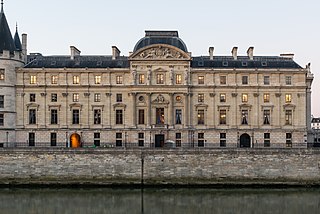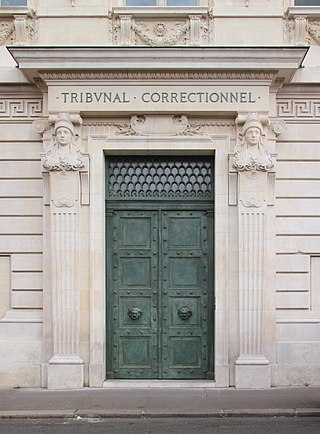Related Research Articles

The Court of Cassation is the supreme court for civil and criminal cases in France. It is one of the country's four apex courts, along with the Council of State, the Constitutional Council and the Jurisdictional Disputes Tribunal.

France's independent court system enjoys special statutory protection from the executive branch. Procedures for the appointment, promotion, and removal of judges vary depending on whether it is for the ordinary or the administrative stream. Judicial appointments in the judicial stream must be approved by a special panel, the High Council of the Judiciary. Once appointed, career judges serve for life and cannot be removed without specific disciplinary proceedings conducted before the council with due process.

The Judiciary of Russia interprets and applies the law of Russia. It is defined under the Constitution and law with a hierarchical structure with the Constitutional Court and Supreme Court at the apex. The district courts are the primary criminal trial courts, and the regional courts are the primary appellate courts. The judiciary is governed by the All-Russian Congress of Judges and its Council of Judges, and its management is aided by the Judicial Department of the Supreme Court, the Higher Qualification Board of Judges, and the Ministry of Justice, and the various courts' presidents. And although there are many officers of the court, including jurors, the Prosecutor General remains the most powerful component of the Russian judicial system.

The judicial system of Turkey is defined by Articles 138 to 160 of the Constitution of Turkey.
In France, a cour d'assises, or Court of Assizes or Assize Court, is a criminal trial court with original and appellate limited jurisdiction to hear cases involving defendants accused of felonies, meaning crimes as defined in French law. It is the only French court that uses a jury trial.

The Court of Cassation of Belgium is the supreme court of the Belgian judiciary. The court is composed of thirty judges with life tenure who are nominated by the High Council of Justice of Belgium and appointed by the Belgian federal government. The court handles cases in the two main languages of Belgium, Dutch and French, and provides certain facilities for cases in German. The court is assisted in its work by a public prosecutor's office and a bar association, which both function separately from other structures. The duty of the public prosecutor's office is to provide advisory opinions to the court on how the law ought to be interpreted and applied. The attorneys of the court's bar association assist litigants in proceedings before the court; in certain cases, their assistance is mandatory.

In most legal jurisdictions, a supreme court, also known as a court of last resort, apex court, and highcourt of appeal, is the highest court within the hierarchy of courts. Broadly speaking, the decisions of a supreme court are binding on all other courts in a nation and are not subject to further review by any other court. Supreme courts typically function primarily as appellate courts, hearing appeals from decisions of lower trial courts, or from intermediate-level appellate courts. A Supreme Court can also, in certain circumstances, act as a court of original jurisdiction, however, this is typically limited to constitutional law.

The judicial reform of Alexander II is generally considered one of the most successful and consistent of all his reforms. A completely new court system and order of legal proceedings were established. The main results were the introduction of a unified judicial system instead of a cumbersome set of estates of the realm courts, and fundamental changes in criminal trials. The latter included the establishment of the principle of equality of the parties involved, the introduction of public hearings, the jury trial, and a professional advocate that had never existed in Russia. However, there were also problems, as certain obsolete institutions were not covered by the reform. Also, the reform was hindered by extrajudicial punishment, introduced on a widespread scale during the reigns of his successors – Alexander III and Nicholas II.
In France prior to 2020, the Tribunal d'instance was a judicial lower court of record of first instance for general civil suits and included a criminal division, the Police Court, which heard cases of misdemeanors or summary offences (contraventions). Since it had original jurisdiction, the Court's rulings could be appealed to a French appellate court or Supreme Court. Prior to 1958, the court was known as a Justice of the Peace Court until the judicial restructuring of 1958.

The courts of appeal are the main appellate courts in the judicial system of Belgium, which hear appeals against judgements of the tribunals of first instance, the enterprise tribunals and the presidents of those tribunals in their judicial area. There are five courts of appeal for each of the five judicial areas, which are the largest geographical subdivisions of Belgium for judicial purposes. The division of the Belgian territory into the five judicial areas is laid down in article 156 of the Belgian Constitution. A judicial area covers multiple judicial arrondissements ("districts"), except for the judicial area of Mons. Each arrondissement has a tribunal of first instance. Further below, an overview is provided of the five courts of appeal and the judicial arrondissements their judicial area covers. It is important to note that the courts of appeal do not hear appeals against judgements of the labour tribunals; these are heard by the courts of labour.

The judiciary of the Republic of Chile includes one Supreme Court, one Constitutional Court, 17 Courts of Appeal, 84 Oral Criminal Tribunals and Guarantee Judges; 7 Military Tribunals; over 300 Local Police Courts; and many other specialized Tribunals and courts in matter of family, labor, customs, taxes, electoral affairs, etc.

The Judiciary of Spain consists of Courts and Tribunals, composed of judges and magistrates (Justices), who have the power to administer justice in the name of the King of Spain.

In the judiciary of Russia an office of the magistrate or justice of the peace, is a judge that handles minor civil and criminal cases. Magistrates handle criminal cases where imprisonment is for less than three years such as slander, petty hooliganism, public drunkenness, and serious traffic violations of a non-criminal nature, minor civil cases such as simple divorces, some property cases, disputes over land, and some labor cases, as well as some federal administrative law cases.

The judiciary of Belgium is similar to the French judiciary. Belgium evolved from a unitary to a federal state, but its judicial system has not been adapted to a federal system.
The judiciary of Luxembourg comprises a number of courts.

The Judiciary of the Netherlands is the system of courts which interprets and applies the law in the Netherlands.

In France, the correctional court is the court of first instance that has jurisdiction in criminal matters regarding offenses classified as délits committed by an adult. In 2013, French correctional courts rendered 576,859 judgments and pronounced 501,171 verdicts.

The Supreme Court of the Dominican Republic is the highest court existing in the Republic and is, therefore, the head of the judiciary in the country.
In France the jurisdictions of the ordre judiciaire, of the French court system are empowered to try either litigation between persons or criminal law cases. They may intervene:

The Supreme Court of the Republic of Latvia or the Senate of Latvia is the highest level court in the three-tiered court system of Latvia. It deals with criminal, civil and administrative matters. Its oversight is determined in the Constitution, the structure and competence of the court are established by the Act On Judicial Power. The Court consists of the Civil Cases Court, three departments, administration and two divisions, located in the Palace of Justice on Brīvības bulvāris, Central Riga.
References
- 1 2 3 4 5 6 7 8 9 One or more of the preceding sentences incorporates text from a publication now in the public domain : Chisholm, Hugh, ed. (1911). "Russia". Encyclopædia Britannica . Vol. 23 (11th ed.). Cambridge University Press. pp. 877–878.
- ↑ An ukaz of 1879 gave the governors the right to report secretly on the qualifications of candidates for the office of justice of the community. In 1889 Alexander III abolished the election of justices of the community, except in certain large towns and some outlying parts of the empire, and greatly restricted the right of trial by jury. The confusion of the judicial and administrative functions was introduced again by the appointment of officials as judges. In 1909 the Third Duma restored the election of justices of the community.
- ↑ The justices, though noble-landowners, are almost exclusively of very moderate means, and, though elected by the land-owning class, they are — according to Leroy-Beaulieu — prejudiced in favour of the poor mujik rather than of the wealthy landlord.
- ↑ This corresponded to the French cour d'arrondissement, but its jurisdiction is, territorially, much wider, often covering several districts or even a whole government.
- ↑ The abolition of the special courts of the peasants was announced in the same imperial ukaz (18 October 1906) which promised the relief of the peasants from the arbitrary control of the communes, and permission for them to migrate elsewhere without losing their communal rights. This was made part of the general reform of Russian local government, which in the autumn of 1910 was still under the consideration of the Duma.